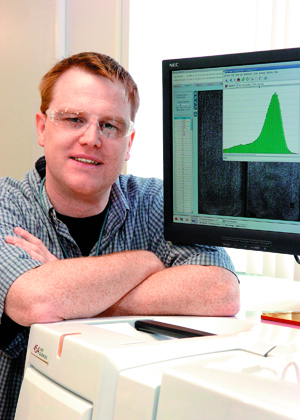Bacteria breakdown
By Shira Tevah, AB'09
Photograph courtesy Argonne National Laboratory
 Computational biologist Folker Meyer studies carbon sequestration. More specifically, he studies the role that microorganisms play in that process, which may offer a solution to the excess carbon dioxide that contributes to climate change. During sequestration, CO2 in the soil becomes a mineralized form of carbon similar to charcoal. Dirt-dwelling bacteria mediate the process, but scientists don’t know precisely how.
Computational biologist Folker Meyer studies carbon sequestration. More specifically, he studies the role that microorganisms play in that process, which may offer a solution to the excess carbon dioxide that contributes to climate change. During sequestration, CO2 in the soil becomes a mineralized form of carbon similar to charcoal. Dirt-dwelling bacteria mediate the process, but scientists don’t know precisely how.
Meyer investigates that question using a DNA sequencing instrument called the Illumina Solexa Genome Analyzer. Purchased by Argonne National Laboratory last summer, the Solexa generates DNA characters that represent gene fragments. Meyer and his research team link those characters to known genes with specific characteristics, allowing them to “figure out the genes that are present in the microbes and what they do.”
The bacteria contain enzymes that “digest certain substances, alter the chemical properties of others, and degrade biological material,” says Meyer, associate director of Chicago’s Institute for Genomics and Systems Biology. The CO2 captured by plants returns to the atmosphere as those plants die, but sequestered CO2 “remains in the soil for centuries.”
Starting with a soil sample, Meyer’s team removes the bacteria, isolates the DNA, and runs it through the Solexa. In the past, researchers had to grow microbes in a lab, severely limiting the varieties they could analyze. New sequencing technology “enables us to get a glimpse of the metabolic pathways of microbes,” Meyer says—“what they eat, what they spit out, and how they influence the soil.”
The Solexa signifies what Meyer calls “the first major change in sequencing technology since 1977,” when the first sequencing machine was built. It produces 17 billion DNA characters per run at a cost of $10,000. “Two years ago,” Meyer says, “we would have paid $2.5 million more” for the same amount of data. With access to millions or billions of species, Meyer says, “we can help devise strategies for optimizing long-term carbon storage,” like changing land-management practices or adding minerals to agricultural fertilizers.
